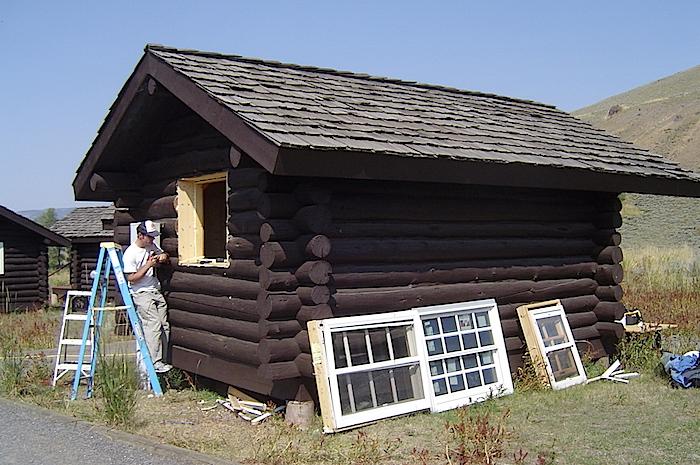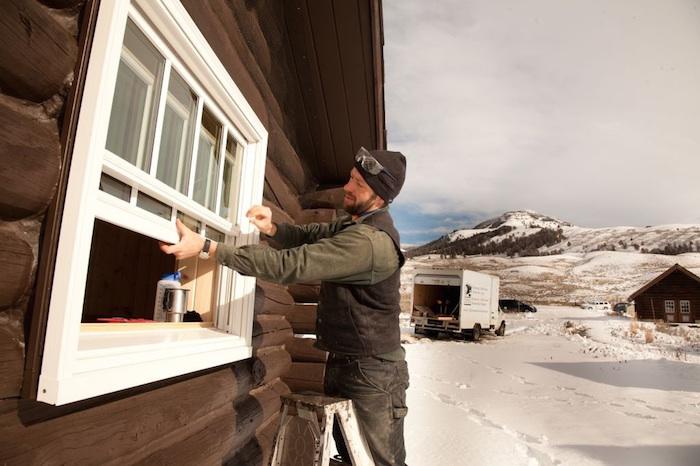
Winter's cold will be tested to infiltrate cabins at the Lamar Buffalo Ranch in Yellowstone thanks to new insulated windows donated by Andersen Windows/Yellowstone Association
Keeping warm in Yellowstone National Park in winter can be extremely challenge, especially when the temperature drops to 40 below zero and the winds pick up to 20+ mph. But thanks to some corporate help in recent years, staying warm in some buildings is easier than in the past.
At the Buffalo Ranch in the Lamar Valley, a medical clinic, and an employee dorm, new windows courtesy of Andersen Windows are doing a better job of keeping the wintry cold out than the old versions. And a sustainable energy system made with components from Toyota, Sharp, Indy Power, Georgia Tech, and Canyon Industries not only has taken the Buffalo Ranch off the grid, but should achieve zero fossil fuel use for daily operations, according to the Yellowstone Association, which along with the Yellowstone Park Foundation and the National Park Service worked with the businesses to make the sustainability project come to fruition.
The new employee dormitory near Old Faithful received “Platinum” rating by the US Green Building Council’s Leadership in Energy & Environmental Design program. The Andersen 100 Series windows donated for the project use reclaimed wood fiber (sawdust) from Andersen’s manufacturing operations as a main ingredient, and is one of the most energy efficient windows available, according to Jay Lemke, who handles public relations for Andersen.
According to Mr. Lemke, the dormitory and other environmental projects within the Y.E.S. (The Yellowstone Environmental Stewardship) initiative have the following goals:
* 15 percent reduction in water consumption by 2016
* 15 percent reduction in electricity consumption by 2016
* 18 percent reduction in fossil fuel consumption by 2016
* 30 percent reduction in greenhouse gas (GHG) emissions by 2016
* 50 percent reduction in greenhouse gas (GHG) emissions by 2025
* 100 percent landfill diversion of municipal solid waste by 2016
At the employee dormitory, solar panels installed on the building’s roof should generate 11 percent of its electricity needs. The residence’s entry staircase treads were built from cedar reclaimed from a deconstructed Montana cabin in partnership with the state Department of Environmental Quality.
"Because the work site was located in an extremely sensitive and active thermal area, extra care was taken to protect existing topsoil and control erosion and sedimentation," said Mr. Lemke. "More than 94 percent of construction waste was recycled or reused so that it was not transported to the landfill, the closest of which was 150 miles from the site
Water usage in the building will be reduced by 45 percent.
The residence was built by concessioner Yellowstone National Park Lodges, operated by Xanterra Parks & Resorts. The building was designed by Mosaic Architects in Helena, and Montana-based Swank Enterprises was the general contractor on the project.

Installing windows at the Buffalo Ranch/Yellowstone Association
Back at the Buffalo Ranch, Toyota helped install an "innovative distributed energy system that combines solar power generation with re-used Camry Hybrid battery packs."
The system is providing "reliable, sustainable, zero-emission power to the ranger station and education center for the first time since it was founded in 1907," according to Toyopta officias.
The partnership among Toyota, Indy Power Systems, Sharp USA SolarWorld, Patriot Solar, National Park Service and Yellowstone Park Foundation is seen as an "innovative effort to extend the useful life of hybrid vehicle batteries while providing sustainable power generation for one of the most remote, pristine areas in the United States."
While solar panels generate the electricity, 208 used Camry Hybrid nickel-metal hydride batter packs store it.
According to Toyota, "On an annual basis, the solar system generates enough electricity to power six average U.S. households for a year, or plenty of power for the five buildings on the ranch campus. The hybrid batteries provide 85kWh of energy storage to ensure continuous power, as the system charges and discharges. Onsite micro-hydro turbine systems, capturing energy from a neighboring stream, are scheduled to join the power mix in 2016."
This marked the first time that reused hybride vehicle batteries were used for commercial energy storage



Comments
This is the kind of corporate help NPS really needs.
And it appears it's being done without a lot of grandstanding, self-congratulations and "Look at What We're Doing!" advertising.
Agreed on both points, Lee. Moreover, it can help sort out experientially steps to take or not take into the future.